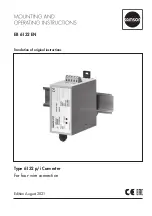
Managing the Encoder
Configuring the Stream Settings
Makito User’s Guide, v2.1.0, Issue 01
85
Configuring the Stream Settings
The Makito provides a
S
TREAM
O
VERVIEW
page and separate
S
TREAM
S
ETTINGS
configura-
tion pages for up to eight streams. From the
S
TREAM
S
ETTINGS
pages, you can manage the
settings for each Encoder stream, start and stop the streams, as well as pause and resume
streams (see
The Makito supports two types of stream configurations:
•
Unicast
– Enter a unicast destination IP address.
•
Multicast
– Enter a multicast destination IP address.
NOTE
You can specify up to eight active streams (or 16 active RTSP streams). The
supported total stream bitrate is up to:
• 30 Mbps audio/video bitrate (TS over UDP or Direct-RTP),
• 25 Mbps audio/video + metadata (TS over UDP), or
• 16 Mbps audio/video bitrate with VF AES and FEC enabled.
To configure “HiLo” Video and/or Audio streaming, you must create an encoder stream for
each encoder instance. For more information on HiLo streaming, see
71 and
You can also enable or disable SAP network announcements. Session Announcement
Protocol (SAP) is a protocol for advertising multicast or unicast session information. SAP
periodically multicasts session description information on an industry standard multicast
address and port. When received by remote participants, these announcements can be used
to generate playlists and facilitate the viewing of streams by eliminating the need for user
configuration. For example, they may be used to automatically create program listings to
allow streams to easily be located, selected and viewed.
Stream Overview Page
The
S
TREAM
O
VERVIEW
page displays a summary of defined streams for the encoder. The
S
TREAM
O
VERVIEW
page displays the Stream Protocol, IP Address, Port, Video Mode (i.e.,
“High” or “Low” stream instance), and selectable Actions for each stream. It also provides
an option for you to either restart (Active), Stop or Remove the stream. Multiple streams
can be either Multi-stream copies or HiLo stream instances or both.
This table includes streams defined using either the
















































